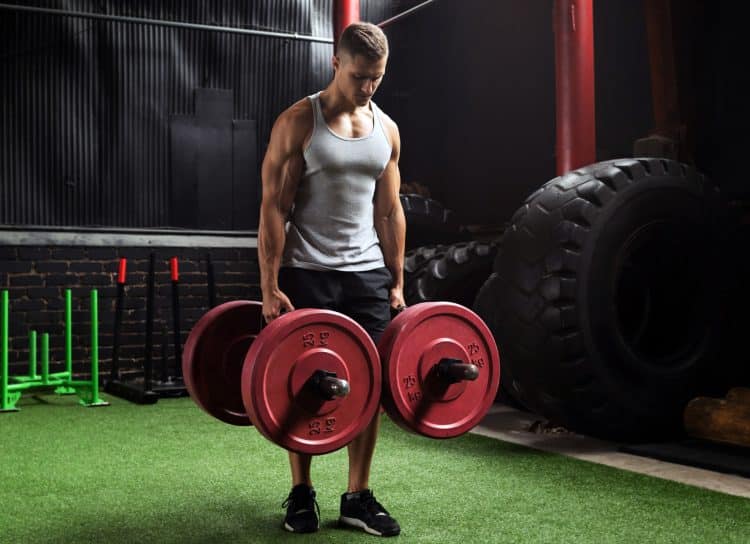Think Vikings, and what comes to mind? Ferocious intensity, raw power, and a warrior mindset.
Imagine channeling that energy into your workouts, minus the mayhem!
Inspired by the Vikings (2013) TV series, I had the crazy idea of training like the legendary Norsemen. I wanted to see if I could develop the functional, powerful physique that enabled the Vikings to do their thing.
I followed a Viking-inspired workout and the Norse diet for 45 days. It was one of the most brutal training experiences of my life, but the results made it all worth it. In this article, I’ll provide a bird’s-eye view of the entire experience. I’ll also share my before-and-after strength, mental resilience, and endurance changes.
Viking Fitness Program Research and Preparation
“Wake early if you want another man’s life or land. No lamb for the lazy wolf. No battle’s won in bed. — Wisdom of the North: The Havamal [1]”
Level Up Your Fitness: Join our 💪 strong community in Fitness Volt Newsletter. Get daily inspiration, expert-backed workouts, nutrition tips, the latest in strength sports, and the support you need to reach your goals. Subscribe for free!
This verse from a famous Norse poem perfectly encapsulates the Viking spirit: wake up early, go hard, and take no prisoners!
It’s a mindset that has always resonated with me, especially when it comes to working out. So, when I saw the recreation of Viking life on the TV series, I was motivated to create a Viking workout, match it with the Norse diet, and follow it for 45 days.
My first step was to research what the Vikings did to forge their bodies and minds. The Vikings were renowned for their raw power and mental ferocity. Their bodies were built not in a gym but through constant, unrelenting daily physical activity.
Famous as raiders, the Vikings spent a lot of time on the water. That meant hour after hour of rowing the oars of a longboat. That constant back-and-forth action forged thick backs, powerful shoulders, biceps, triceps, forearms, and glutes. [2]
To emulate this, I incorporated rowing machine sessions into my routine. These sessions were designed to simulate the long and grueling rowing sessions of the Vikings, pushing my endurance to new levels.
Having arrived at their raiding destination, the Vikings charged from their longboats, wielding a battle ax overhead and carrying a round wooden shield. To prepare for combat, the Norsemen lifted heavy stones and carried weights of various shapes and sizes. Everyday activities like farming, woodcutting and shipbuilding also built their strength and endurance.
Viking-Inspired Exercises
To develop the functional strength of a Viking, I needed to train differently from the body part-specific bodybuilding workouts I was used to. I needed to emphasize overall body strength with compound exercises involving more than one joint.
Here are some exercises I used to simulate the type of training done by the Vikings:
- Farmer’s Walk: This exercise mimics the action of carrying heavy loads that would have been a daily experience for Viking men. The farmer’s walk develops the shoulders, upper trapezius, forearms, core, and quads.
- Tire Flip: The tire flip builds the brute strength needed for Viking activities like lifting heavy stones and logs. It builds explosive power and functional strength, emphasizing the legs, back, shoulders, and core.
- Tire Smash: Smashing a sledgehammer repeatedly into a tire is an effective, safe way to channel the axe-wielding antics of the Viking warrior. The repetitive, powerful swinging action provides a great cardio workout while developing the shoulders, arms, core, and quads.
- Sandbag Clean and Press: Using a sandbag for the clean and press reflects the uneven, challenging loads the Vikings constantly handled. This move builds the shoulders, arms, back, legs, and core.
- Burpees: Burpees mimic the high-intensity, full-body movements required for Viking combat and endurance. It’s an excellent endurance builder that hits nearly every muscle in your body.
- Push-Ups: The push-up is a foundational upper body strength builder. The Norsemen may have used it to build the strength to carry weapons and heavy loads.
- Pull-ups: Pull-ups build upper body and grip strength, which was essential for the climbing, pulling, and combat scenarios the Vikings faced.
Viking-Inspired Training Routine
To simulate the hard, fast, take-no-prisoners Viking style, I combined the exercises into a circuit. That meant charging from one exercise to the next without rest. Each circuit consisted of five exercises.
I set my timer to 90 seconds for each exercise. My goal was to keep pumping out reps until I heard it beep. I then had 15 seconds to get in position for the next exercise. If I failed an exercise before the 90 seconds were up, I allowed myself a five-second count before getting back into it.
The circuit was done for three rounds with a two-minute rest between rounds.
The workout started with ten minutes on the rowing machine. After a moderate two-minute warm-up, I alternated 30-second sprints with 30-second recoveries for eight minutes.
After the five-exercise circuit, I returned to the rowing machine for another ten-minute high-intensity rowing session. This time, there was no warm-up — just ten rounds of sprints and recoveries!
I trained six days weekly on this program, using two exercise circuits. Each circuit was followed on three of the days. Here’s what my weekly schedule looked like:
| Monday | Tuesday | Wednesday | Thursday | Friday | Saturday | Sunday |
| – Rowing
– Circuit A – Rowing |
– Rowing
– Circuit B – Rowing |
– Rowing
– Circuit A – Rowing |
– Rowing
– Circuit B – Rowing |
– Rowing
– Circuit A – Rowing |
– Rowing
Get Fitter, Faster
Level Up Your Fitness: Join our 💪 strong community in Fitness Volt Newsletter. Get daily inspiration, expert-backed workouts, nutrition tips, the latest in strength sports, and the support you need to reach your goals. Subscribe for free! – Circuit B – Rowing |
– Rest Day |
Circuit A:
- Sandbag Clean & Press
- Tire Flip
- Burpees
- Pull-Ups
- Farmer’s Carry
Circuit B:
- Tire Smash
- Push-ups
- Pull-ups
- Tire Flip
- Burpees
My Experience Training Like a Viking For 45 Days
I’ve been working out for decades and have tried many different approaches. Yet, my 45-day Viking experience was one of the most challenging training programs I’ve ever followed. Once the two-minute warm-up on the rowing machine was over, there was no pause: it was pedal to the metal the whole way through!
This workout wasn’t just about pushing my body to the limit but also a test of mental strength and endurance. Every day, I had to face the challenge of pushing through each 90-second physical challenge as I mimicked the stamina of the Viking warrior. It needed to summon every ounce of inner strength to keep going when physical and mental fatigue set in.
As the days turned into weeks, I noticed changes in my physical abilities and mental strength. The circuit training and high-intensity rowing combination pushed my physical limits. I became stronger and eventually was able to complete each exercise for the full 90 seconds without rest, even on the third round of the circuit.
By the end of the 45 days, I’d made significant strength improvements. Prior to the program, I could pump out 84 push-ups in a row. On the day after I completed my 45-day Viking workout program, I did 117!
I had equally impressive results on pull-ups. My best before the program was 15 reps with good form. That went up to 23 good reps after the Viking program.
I weighed 213 pounds at the start of the program, and my body fat percentage was 16 percent. The day after I completed the program, I weighed 205 pounds, and my body fat percentage had come down to 14.2 percent.
Those results really impressed me. The relentless pace of the workouts and all of the rowing I did revved up my metabolism, essentially turning my body into a fat-burning machine. I have never been able to drop nearly two percentage points of body fat in a month and a half!
This workout gave me a profound sense of accomplishment. I’d pushed through barriers, physical and mental, that I hadn’t previously thought possible. The Viking regimen had transformed my body and my mindset, instilling a resilience that carries forward into all aspects of my life.
The Viking (Nordic) Diet
Along with my 45 days of Viking workouts, I adopted the Nordic diet. Based on the Viking way of eating, the Nordic diet is similar to the Mediterranean diet. However, it emphasizes grains like oats and barley, root vegetables like carrots and beets, and seafood like salmon and herring.
The Nordic diet also features a range of berries, such as blueberries, bilberries, and blackberries, to provide antioxidants and vitamins. Foods are seasoned with herbs, spices, and wild plants to reduce salt and sugar intake. [3]
To integrate the Nordic diet into my eating plan, I increased my intake of lean proteins, like chicken and fish. I don’t usually eat salmon and herring, but I added two dinner servings per week.
My complex carbs came from barley and rye, as well as a range of vegetables, including potatoes, kale, cabbage, beets, carrots, and broccoli. Healthy fats came from nuts, seeds, macadamia, and canola oil.
The nutrient-dense foods from the Nordic diet helped me recover between my daily workouts. This was due to a combination of the complex carbs from oats and the faster-acting carbs I got from berries, honey, and wholegrain bread.
Before my workouts, I had a bowl of oatmeal, walnuts, and berries sprinkled with protein powder. Within 20 minutes of completing the workout, I ate a piece of toast topped with honey to replace my depleted glycogen levels. I also had a protein shake within the hour after my workout to provide the amino acids to fuel protein synthesis.
This diet and my cardio-burning workouts helped me drop nearly two percentage points in body fat. While I didn’t cut back on calories, my eating over those 45 days was considerably cleaner than it had been previously.
The balanced meals provided sustained energy throughout the day. I needed that to maintain intensity during the demanding exercise circuits.
Viking Workout vs. Modern Training
The Viking-inspired workout I followed for 45 days differed significantly from how I usually train. My usual approach is based on modern training concepts emphasizing specialization and isolation of body parts. The Viking approach was built around holistic strength and endurance through functional, full-body movements.
The exercises I selected for the Viking workout mimicked the practical activities of Viking life. In these activities, multiple muscle groups work together. As a result, I included compound functional exercises like tire flips, sandbag clean and press, and farmer’s walk.
The Viking workout was structured to copy the Viking approach of intense, fast work. To do this, I used high-intensity circuits with minimal rest. These were bookended by the HIIT rowing sessions. This structure mimicked a Viking raid, which involved a long row, a period of intense looting and plundering, and then a saft rowing getaway.
I quickly discovered that the Viking workout was also a test of mental resilience. Its nonstop nature requires mental toughness to push through fatigue and discomfort.
In contrast, modern training methods often involve targeting specific muscle groups with isolation exercises. These workouts are designed to promote targeted hypertrophy and strength gains.
Modern fitness programs use various techniques, including plyometrics, interval training, and strength training with weights. They also incorporate more intra-workout recovery opportunities than I experienced with the Viking workout.
The Viking workout was mentally more challenging and did a better job building endurance, explosive power, and full-body strength.
Wrap Up
The Viking-inspired fitness training and diet program challenged me at every level. The workouts were brutal, demanding total focus and determination. Needless to say, I looked forward to my one day off each week every Sunday.
Going forward, I think I’ll cut back to five days weekly to make the program more physically and mentally sustainable. That should allow me to continue for 90 days. Before that, though, I’ll spend a couple of months back on my standard, less demanding routine.
Do you think you’re ready to take on the Viking workout challenge? I encourage you to try it — you will find the experience transformative!
References
- Larrington, C. (Trans.). (2014). The Poetic Edda (Rev. ed.). Oxford University Press. (Original work composed c. 1200)
- Winroth, A. (2014). The Age of the Vikings. Princeton University Press.
- Adamsson V, Reumark A, Cederholm T, Vessby B, Risérus U, Johansson G. What is a healthy Nordic diet? Foods and nutrients in the NORDIET study. Food Nutr Res. 2012;56. doi: 10.3402/fnr.v56i0.18189. Epub 2012 Jun 27. PMID: 22761599; PMCID: PMC3386552.













